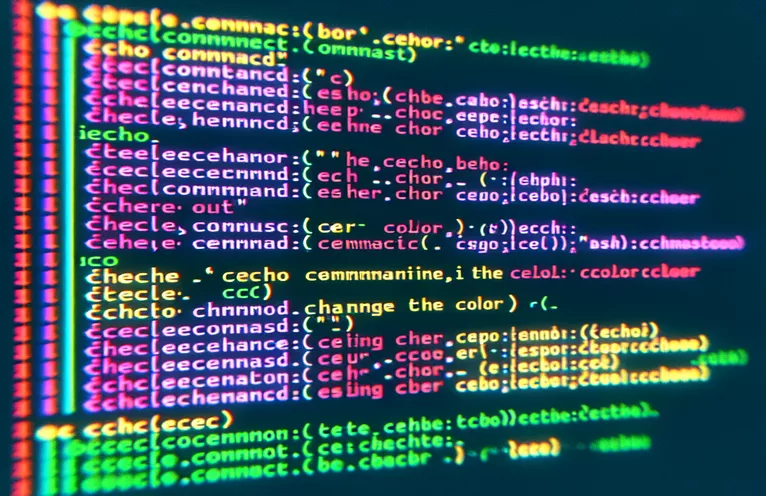Customizing Terminal Text Color in Linux
When working in the Linux terminal, you may want to change the color of text output to improve readability or highlight key information. This can be especially useful in scripts or for displaying messages to people.
In this post, we will look at how to utilize the 'echo' command to print text in red. This simple trick can improve the visual appeal of your terminal output and make it easier to navigate.
| Command | Description |
|---|---|
| #!/bin/bash | Specifies that the script should be executed in the Bash shell. |
| RED='\033[0;31m' | Sets a variable to the ANSI escape code for red text. |
| NC='\033[0m' | Defines a variable that resets the text color to its default. |
| echo -e | Allows for the interpretation of backslash escapes in the echo command. |
| \033[0;31m | ANSI escape code for changing the text color to red. |
| \033[0m | ANSI escape code for resetting text color to its default. |
| print_red() | Defines a Bash function that prints text in red. |
Exploring Bash Scripts for Text Color Customization.
The provided scripts show how to alter the output color of text on the terminal using the echo command in Bash. The first script defines the ANSI escape codes for red and no color in variables RED='\033[0;31m' and NC='\033[0m'. The echo -e command enables the interpretation of backslash escapes, which is required for the ANSI codes to be handled properly. By enclosing the text in these variables, we get the required red text output followed by a return to the default color.
The second script introduces the function print_red(). This method facilitates printing red text by wrapping the echo command with ANSI escape codes. The function receives a string parameter, which is subsequently printed in red. This function provides a reusable mechanism to print red text throughout the script. The third and fourth scripts use similar principles but demonstrate alternative ways of structuring and calling the commands to achieve the same result: guaranteeing that the text is red and subsequently returning to its usual color.
Using Bash to Change the Terminal Text Color
Shell Scripting in Bash
#!/bin/bash# Script to print text in red colorRED='\033[0;31m'NC='\033[0m' # No Colorecho -e "${RED}This text is red${NC}"
Applying ANSI Escape Codes in Echo Command
Bash Script for Terminal Colour Output
#!/bin/bash# Function to print in redprint_red() {echo -e "\033[0;31m$1\033[0m"}# Calling the functionprint_red "This is a red text"
Customizing Terminal Output with Color
Using ANSI code in Bash
#!/bin/bash# Red color variableRED='\033[0;31m'NC='\033[0m' # No ColorTEXT="This text will be red"echo -e "${RED}${TEXT}${NC}"
Coloring Echo Output in Linux
Bash script for colored text.
#!/bin/bash# Red color escape codeRED='\033[0;31m'NC='\033[0m' # No ColorMESSAGE="Red colored output"echo -e "${RED}${MESSAGE}${NC}"echo "Normal text"
Advanced Techniques for Terminal Text Coloring in Bash
Another feature of customizing terminal output in Bash is to use different colors for distinct messages, such as warnings, problems, or success. This can be accomplished by specifying several ANSI escape code variables. For example, you can choose GREEN='\033[0;32m' for success messages and YELLOW='\033[0;33m' for warnings. By including these variables into your scripts, you may develop a more user-friendly interface with visual clues based on the type of message being presented.
Additionally, conditional expressions and loops help improve the script's functionality. You can use if statements to monitor the progress of a command and produce a success or error message as needed. Loops can be used to iterate across many files or inputs and provide consistent color-coded feedback. Combining these strategies with color modification results in more robust and informative scripts that are easier to read and troubleshoot.
Frequently Asked Questions About Terminal Text Coloring
- How can I change the text color in Bash?
- Use ANSI escape codes with the echo command, like RED='\033[0;31m' and echo -e "${RED}Text${NC}".
- Can I use colors other than red?
- Yes, different colors can be defined using their corresponding ANSI codes, such as GREEN='\033[0;32m' and YELLOW='\033[0;33m'.
- What does NC='\033[0m' do?
- It returns the text color to the default terminal color.
- Do I have to use the -e flag with echo?
- Yes, the -e flag interprets backslash escapes, allowing ANSI codes to function.
- Can I alter the color of text in different shells?
- Yes, however the syntax may vary. The concepts are comparable across shells, such as Zsh and Fish.
- How can I integrate color in a Bash script?
- Define color variables and use them in your script using echo -e or functions.
- Can I blend multiple colors in a single line?
- Yes, you can include different color codes into the text, such as echo -e "${RED}Red${GREEN}Green${NC}".
Finishing up: Terminal Text Color in Bash.
Changing text color in the terminal using Bash scripts is an effective approach to improve the readability and organization of your outputs. Using ANSI escape codes with the echo command allows you to easily highlight critical information and make your scripts more user-friendly. Using these strategies can result in more efficient and visually appealing terminal interactions.


